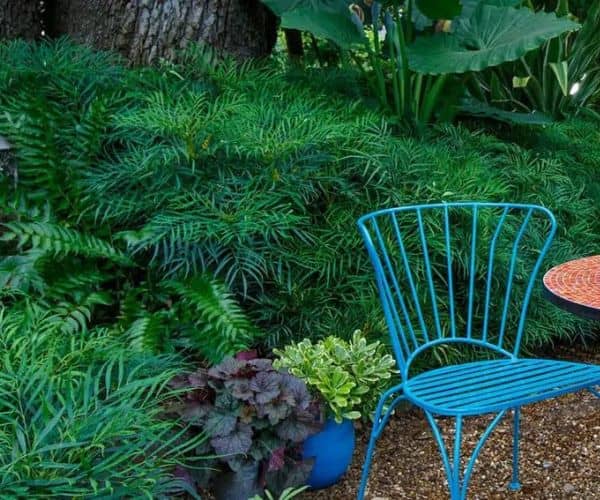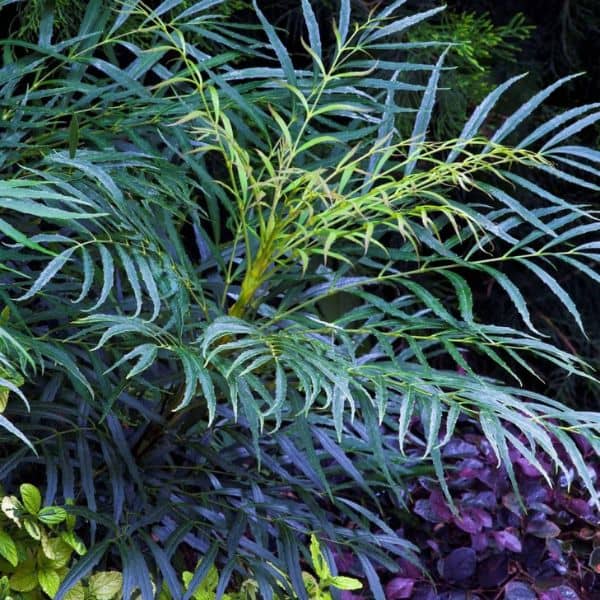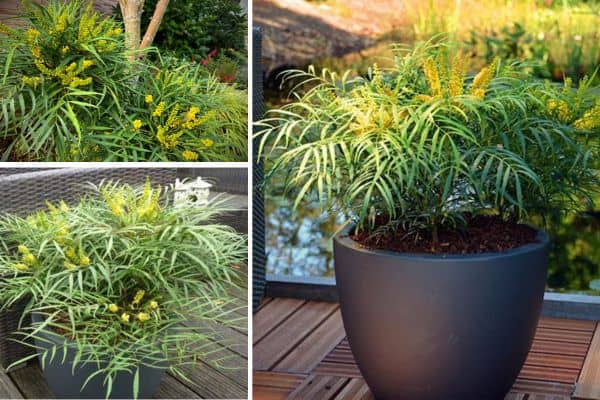Soft Caress Mahonia, also known as Mahonia eurybracteata is a beautiful and captivating evergreen shrub native to China, that has gained popularity in recent years.
Unlike its spiny-leaved cousins, this mahonia variety features soft, delicate foliage that is a delight to touch. In the late fall and early winter, the plant produces clusters of fragrant, bright yellow flowers that attract bees and butterflies.
Common Name: Soft Caress Mahonia, Anpung Mahonia, Barberry, Oregon Grape
Botanical Name: Mahonia eurybracteata
Category: Shrub
Height: 3 to 5 feet
Sun Exposure: Partial to Full Shade
Bloom Time: Late Fall to Early Winter
Fruit Time: Late Spring to Early Summer
Leaf Shape: Lance
Soil: Loam
In detail Soft Caress Mahonia
Soft Caress is a compact shrub that typically grows to about 3-5 feet tall and wide, which makes it a versatile and low-maintenance addition to any garden. Its beautiful relatives have spiky leaves with razor-sharp thorny edges which might make them slightly less appealing but the feathery lightness of the leaves of Soft Caressa Mahonnia makes it
It is a perennial that works well as an understory planting below Japanese maples and other shade trees. It thrives in deeply shaded areas where ferns are usually the first go-to plants and its bamboo-like foliage makes it the perfect selection for an Oriental garden theme.
Growing Conditions for Soft Caress
Sunlight
When planting Soft Caress, choose a location that receives partial to full shade and has well-draining soil. This plant prefers some to full shade, which means it will do quite well in that area in your garden that you think is not ideal for most plans because of lack of sunlight.
Although it is adapted to grow in shade, it is able to tolerate some morning sunlight but cannot endure continued exposure to direct sunlight as it will burn its leaves.
Key Points
- Plant in partial to full shade
- Use well-draining soil
Soil Requirements
Well-drained soil, slightly acidic soil is loved by Soft Caress above neutral soil. Although it can tolerate a wide range of soil conditions, adequate drainage is important to avoid root rot. Also, you can add organic matter to the soil to improve its fertility, making it the perfect environment for the growth of your plant.
Watering and Fertilizing
Soft Caress is drought tolerant but benefits from regular watering during periods of extreme heat or drought. Water deeply at the base of the plant to encourage deep root growth. Fertlixze in spring with a slow-release balance fertilizer to promote healthy growth and flowering.
This plant loves moist well-drained soil, so water regularly during dry periods to keep the soil evenly moist but not waterlogged.
- Water deeply during periods of drought.
- Fertilize in the spring with a balanced fertilizer.
Pruning
In general, Soft Caress Mahonia requires little pruning than the regular form of this evergreen shrub. In the spring, it is recommended to prune any deceased or fallen branches in order to monitor the trees’ proper shape and health. Pos flowering light pruning can also be done to help create harder branching habits.
Landscape Uses
Soft Caress Mahonia is a versatile plant with many potential uses in the garden, Its compact size and shade tolerance make it well suited for planting in small, shady spaces, such as under trees or along paths. It also works well in mass plantings, hedges, or as a focal point in woodland-style gardens. Additionally, this variety can be grown in containers, patios, or decks.

Overall, it is unique and low-maintenance evergreen shrubs that add year-round interest and texture to shady garden spaces. Its soft fern-like foliage and winter blooms make it a captivating addition to any landscape or garden.
Planting Soft Caress Mahonia
When to Plant? It would be advisable to plant Soft Caress Mahona at the start of spring or during the cooler months of the fall which would allow the plants to establish roots without necessarily competing with high temperatures.
How to Plant?
- Grow in dappled sunlight and moisture retentive neutral to alkaline soil.
- For better water drainage and nutrients, the soil should be prepared by adding compost or any form of organic materials on the ground to be covered.
- Cut the hole’s diameter to be twice the size of the root system and its depth to be of the same dimensions, i.e. when you are planting the plant into the hole, the root ball aperture must be level with peripheral soil.
- Full up the hole and press it slightly on and around the roots. Irrigate well until the soil sets and get rid of extra air bubbles within the mix.
- Another thing is to place mulch around the base to help with water retention and also to control heat in the soil.
Propagating Soft Caress Mahonia
These shrubs can be propagated by seeds or by cuttings and Soft Caress Mahonia can be propagated through both methods. Plant propagation by semi-hardwood cutting is most effective if the cutting is taken during the mid to late summer or early the following fall. To propagate dip the cuttings in the rooting hormone and plant in the preferred propagation mix. Use the above-illustrated steps when propagating, and ensure that the settings are placed in a moist environment until root formation occurs.
Companion Plants for Soft Caress Mahonia

Soft Caress Mahonia is a versatile and low-maintenance evergreen shrub that can be paired with a variety of plants to create a beautiful and unique landscape.
1. Everillo Carex, this shade-friendly plan features bright golden foliage that complements the soft, fern-like foliage of Soft Caress Mahonia.
2. Hydrangeas, For partial shade plantings, pair Soft Caress with Hydrangeas like the Big Daddy Hydrangea or Bloomstruck Hydrangea, as their wide leaves and large rounded blooms provide a striking contrast to the delicate foliage of the Mahonia.
3. Hostas, The bold leaves of hostas can be paired with delicate foliage of Soft Caress for a striking contrast.
4. Japenese Maples, Soft Caress can be used as an understory planting beneath Japenese Maples creating a beautiful and elegant landscape.
Pests and Disease Problem
This plant has low pest and disease incidence, and other diseases include leaf roll virus and gall aphids. However, a few things you should watch out for include aphids or scales that are common in gardens.
Insecticidal soaps or neem oil to treat the infestations and reduce the risk of further infestations. To minimize infections by fungal disease, there should be good air circulation, and also irrigation shouldn’t be done from above.
You may like to read more about it, Here are 11 Indoor Palm Plants That Give Your House a Tropical Touch!
FAQs
1. Is soft caress mahonia deer resistant?
Yes, Soft Caress is deer resistant, as deer prefer to avoid this plant due to its relatively spiky leaves, even if it has softer foliage compared to other Mahonia varieties.
2. How big does soft caress mahonia get?
This plant usually reaches a height of three feet and a width of three feet. Due to its tiny size, it may be used in larger landscapes as part of mixed borders or in smaller gardens or containers.
3. Does Mahonia soft caress like shade?
Yes, Soft Caress prefers shade to partial shade and thrives in low conditions, which can be a great option for shaded options in your garden. Although it can withstand some early sun, it thrives in areas with greater shadow since direct sunlight can burn the leaves.
